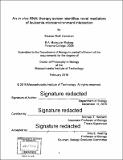| dc.contributor.advisor | Michael T. Hemann. | en_US |
| dc.contributor.author | Cameron, Eleanor Ruth | en_US |
| dc.contributor.other | Massachusetts Institute of Technology. Department of Biology. | en_US |
| dc.date.accessioned | 2016-06-22T17:50:32Z | |
| dc.date.available | 2016-06-22T17:50:32Z | |
| dc.date.copyright | 2016 | en_US |
| dc.date.issued | 2016 | en_US |
| dc.identifier.uri | http://hdl.handle.net/1721.1/103236 | |
| dc.description | Thesis: Ph. D., Massachusetts Institute of Technology, Department of Biology, 2016. | en_US |
| dc.description | Cataloged from PDF version of thesis. | en_US |
| dc.description | Includes bibliographical references. | en_US |
| dc.description.abstract | Minimal residual disease refers to those cancer cells that persist following initial therapy. In precursor B-cell acute lymphoblastic leukemia (BCP-ALL), the presence of minimal residual disease is a strong prognostic indicator of relapse. The establishment of minimal residual disease fundamentally arises from leukemia cells that are resistant to drug-mediated killing due to alterations in a myriad of both cell-intrinsic and cell-extrinsic pathways. Understanding mechanisms by which leukemia cells can survive therapy is vital to our ability to target and eradicate minimal residual disease. BCR-ABL1+ BCP-ALL is an aggressive subtype of BCP-ALL, and despite the use of tyrosine kinase inhibitors (TKIs) as additional therapeutics that directly inhibit BCR-ABLI, more than half of BCR-ABLI+ BCP-ALL patients will experience a relapse. We have adapted an in vivo RNAi screening approach to perform novel longitudinal studies both in mice and in cultured cells to identify genetic mediators of response to the TKI dasatinib in a transplantable syngeneic mouse model of BCR-ABLI+ BCP-ALL. The unique combination of a longitudinal screen design and independent component analysis of screening data allowed for identification of hairpins that have distinct behavior in different therapeutic contexts as well as in the in vivo versus in vitro settings. From the set of hairpins found to have distinct behavior before versus after therapy, we identified AB13 as a potential biomarker of therapeutic response in BCRABLI+ BCP-ALL cells. Knockdown of AB13 promoted resistance to dasatinib in vivo, potentially due to alterations in the invasive capabilities of leukemic cells. We also found that loss of PAFAH1B3 sensitizes cells to dasatinib specifically in the in vivo setting. Changes in Pafah1b3 levels alter the distribution of leukemic cells in vivo, and cells that express higher levels of Pafah1b3 are enriched in the bone marrow after dasatinib treatment. Therefore, sensitization after loss of PAFAHIB3 may result from decreased ability of leukemia cells to migrate to or remain in the bone marrow, an established site of MRD in BCP-ALL. Pafah1b3 is a druggable enzyme and thus represents a potential target for combination therapy with TKIs for BCR-ABLI+ BCP-ALL. | en_US |
| dc.description.statementofresponsibility | by Eleanor Ruth Cameron. | en_US |
| dc.format.extent | 262 pages | en_US |
| dc.language.iso | eng | en_US |
| dc.publisher | Massachusetts Institute of Technology | en_US |
| dc.rights | M.I.T. theses are protected by copyright. They may be viewed from this source for any purpose, but reproduction or distribution in any format is prohibited without written permission. See provided URL for inquiries about permission. | en_US |
| dc.rights.uri | http://dspace.mit.edu/handle/1721.1/7582 | en_US |
| dc.subject | Biology. | en_US |
| dc.title | An in vivo RNAi therapy screen identifies novel mediators of leukemia-microenvironment interaction | en_US |
| dc.type | Thesis | en_US |
| dc.description.degree | Ph. D. | en_US |
| dc.contributor.department | Massachusetts Institute of Technology. Department of Biology | |
| dc.identifier.oclc | 951607316 | en_US |
